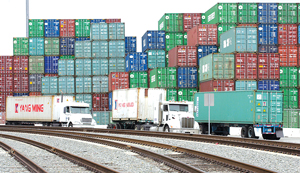
U.S. importers, scrambling to stock their shelves for the holidays, are turning to air freight in volumes not seen since the start of the recession in order to avoid the bottleneck of goods at the ports of Los Angeles and Long Beach.
The pressure to get goods to market quickly has led Long Beach freight-forwarder UTi Worldwide Inc. to begin shipping goods via charter flights from Shanghai, bypassing the L.A. area altogether by delivering direct to Chicago’s O’Hare International Airport.
The weekly flights, said Ed Feitzinger, executive vice president of global operations at UTi, are a direct response to the stifling backlog of cargo at L.A.’s ports.
“If you look at the ports, there’s tens of thousands of containers sitting there,” he said. “There may not be enough labor to move it or they can’t get enough trucks.”
The weekly flights are slated to continue through at least January – or until the ports become less congested.
The vast majority of importers and exporters stopped shipping through the air to cut costs when the recession hit, Feitzinger said, and began transporting cargo over the high seas – a slower yet cheaper alternative.
But the slower option has become too slow.
It takes a cargo ship about two weeks to stream from Asia to Los Angeles, and the time it now takes to get goods from the port to their destinations has been extended. Historically, an L.A. company could expect to receive shipments three or four days after the vessel arrived at the port, Feitzinger said. Now, it often takes two to three weeks.
“That’s the problem for importers right now,” he said. “They don’t know when they’re going to get their product.”
Shipping by air gets goods to the United States in three or four days and gives importers more certainty. Some goods have always been shipped air freight, either because they would spoil after several days on a ship or because they are high-value items shipped in small quantities. The price to ship air freight is based on weight, so Feitzinger said it’s rare to see heavier goods delivered air freight.
“If you at all can avoid it, you don’t ever want to ship anything heavy air freight,” he said.
Labor issues
But many importers didn’t foresee the backlog at the ports. Independent truck drivers have been picketing off and on since the summer, voicing complaints about working conditions and what they say is an inappropriate classification as independent contractors. Those protests have increased recently, creating even more backlog.
Craig Kaplan, chief executive at L.A. logistics company Performance Team, said importers are now shipping goods through the air that are almost always transported ocean freight.
“Shoe vendors are flying things in,” he said. “They’re just avoiding the whole process, just to make sure they’ve got everything they need to make the holiday sales.”
Kaplan estimated it’s at least three or four times more expensive to transport goods via air freight than by ship. Now, retailers are increasingly faced with daunting transportation costs that cut into profit margins significantly.
“You’re diminishing anybody’s ability to make money on their products because you’re increasing the cost of transportation,” he said. “It’s something that’s just killing retailers and it’s going to be killing the economy in the short term.”
The holiday shopping season is traditionally a time retailers look forward to all year, but L.A. retailers are much less enthused this year, said Frances Harder, founder and president of downtown L.A. non-profit Fashion Business Inc.
“They’re anticipating this year to be devastating,” she said. “In clothing, if shipments are kept at the port and retailers can’t access that product, it could strongly impact the actual worth of the products themselves.”
